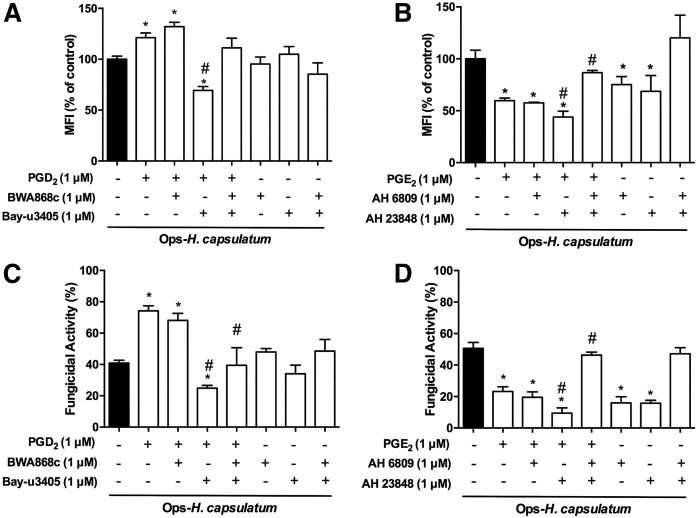Fig. 4.
PGD2 and PGE2 receptors antagonists differently impacted phagocytosis and killing of Ops-H. capsulatum by AMs. AMs were pretreated or not for 20 min with DP1 antagonist (BWA868c; 1 μM) or/and DP2 antagonist (Bay-u3405; 1 μM) before addition of vehicle or PGD2 (1 μM) for 2 min. Subsequently, the cells were infected with Ops-H. capsulatum labeled with FITC (MOI 1:10), and phagocytosis (A) and fungicidal activity (C) were assessed 2 and 48 h later, respectively. In another set of experiments, AMs were pretreated or not with EP2 antagonist (AH 6809; 1 μM) and/or with EP4 antagonist (AH 23848; 1 μM) before the addition of vehicle or PGE2 (1 μM) for 2 min. Subsequently, the cells were infected with Ops- H. capsulatum labeled with FITC (MOI 1:10), and phagocytosis (B) and fungicidal activity (D) were assessed 2 and 48 h later, respectively. Phagocytosis is expressed as average of fluorescence intensity (MFI) from internalized yeast by AMs in vehicle (n = 6). For fungicidal activity, after 48 h, AMs were lysed, and the fungicidal activity was determined as described in Materials and Methods. Fungicidal activity was expressed as a percentage of live yeast recovered (CFU) from cells treated with the antagonists in comparison to total yeast recuperated from AMs incubated with vehicle (100%) (n = 4). * P < 0.05 (AMs + Ops-H. capsulatum vs. other groups); # P < 0.05 (AMs + Ops-H. capsulatum PGD2 or PGE2 vs. treatments). One-way ANOVA and Tukey’s multiple comparison tests were used. Data are representative of four independent experiments (±SEM).

